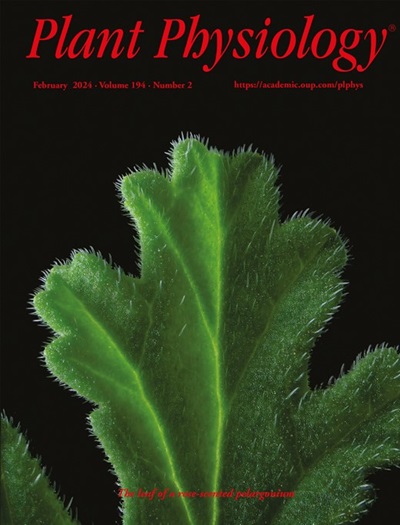The NLR protein CbAR9 and the hydrolase CbSAHH form a module driving systemic acquired resistance against Colletotrichum in pepper
IF 6.9
1区 生物学
Q1 PLANT SCIENCES
引用次数: 0
Abstract
Anthracnose, which is caused by fungal pathogens of the genus Colletotrichum, poses a substantial threat to global pepper (Capsicum spp.) production. However, the principal regulators and signaling pathways that mediate anthracnose resistance remain largely unknown. In this study, we demonstrate the roles of ANTHRACNOSE RESISTANCE 9 (CbAR9) and S-ADENOSYLHOMOCYSTEINE HYDROLASE (CbSAHH) in the methyl salicylate (MeSA) mobile signal activating systemic acquired resistance (SAR) in Capsicum baccatum. Phenotypic and molecular analyses showed that the nucleotide-binding domain and leucine-rich repeat protein CbAR9 enhances both local and systemic defense responses to Colletotrichum species through salicylic acid (SA)-dependent immunity, and it directly interacts with CbSAHH, a key enzyme in the methylation cycle. Knockdown of CbAR9 or CbSAHH significantly impaired SAR to Colletotrichum species. Moreover, the elevation of MeSA content and methylation capacity induced by Colletotrichum capsici in the primary infected leaves were compromised in CbAR9- and CbSAHH-silenced plants. Notably, MeSA treatment in the primary infected leaves restored the diminished SAR to C. capsici in CbAR9- and CbSAHH-silenced plants. These findings show that the CbAR9-CbSAHH module contributes SAR to Colletotrichum species through activating the MeSA mobile signal.NLR蛋白CbAR9和水解酶CbSAHH组成一个模块,驱动辣椒对炭疽病的系统获得性抗性
炭疽病是由炭疽菌属真菌病原体引起的,对全球辣椒生产构成重大威胁。然而,介导炭疽病抗性的主要调节因子和信号通路在很大程度上仍然未知。在这项研究中,我们证明了炭素抗性9 (CbAR9)和s -腺苷型同型半胱氨酸水解酶(CbSAHH)在水杨酸甲酯(MeSA)移动信号激活辣椒系统性获得性抗性(SAR)中的作用。表型和分子分析表明,核苷酸结合域和富含亮氨酸的重复蛋白CbAR9通过水杨酸依赖免疫增强了炭疽病的局部和全身防御反应,并直接与甲基化循环中的关键酶CbSAHH相互作用。敲低CbAR9或CbSAHH显著降低了炭疽菌的SAR。此外,CbAR9-和cbsahh沉默植株初生感染辣椒炭素后叶片中MeSA含量和甲基化能力的升高受到抑制。值得注意的是,在CbAR9-和cbsahh沉默植株的初发感染叶片中,MeSA处理恢复了对辣椒辣椒的SAR降低。这些结果表明,CbAR9-CbSAHH模块通过激活MeSA移动信号对炭黑菌产生SAR。
本文章由计算机程序翻译,如有差异,请以英文原文为准。
求助全文
约1分钟内获得全文
求助全文
来源期刊

Plant Physiology
生物-植物科学
CiteScore
12.20
自引率
5.40%
发文量
535
审稿时长
2.3 months
期刊介绍:
Plant Physiology® is a distinguished and highly respected journal with a rich history dating back to its establishment in 1926. It stands as a leading international publication in the field of plant biology, covering a comprehensive range of topics from the molecular and structural aspects of plant life to systems biology and ecophysiology. Recognized as the most highly cited journal in plant sciences, Plant Physiology® is a testament to its commitment to excellence and the dissemination of groundbreaking research.
As the official publication of the American Society of Plant Biologists, Plant Physiology® upholds rigorous peer-review standards, ensuring that the scientific community receives the highest quality research. The journal releases 12 issues annually, providing a steady stream of new findings and insights to its readership.
 求助内容:
求助内容: 应助结果提醒方式:
应助结果提醒方式:


